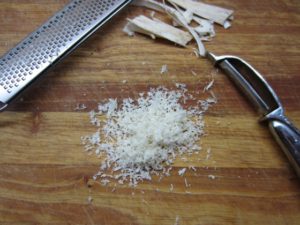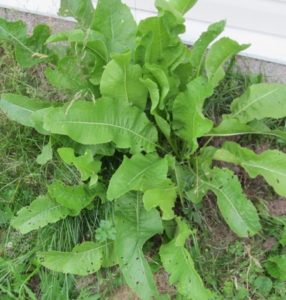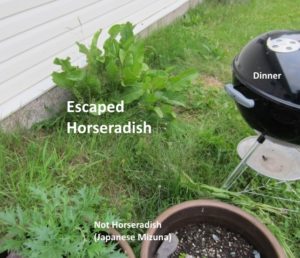You want an edible plant that’s impossible to kill in most any climate? Horseradish is your answer.
If you’ve ever used ‘prepared’ horseradish from jars at the supermarket in your coleslaw, tartar sauce, or to dress a bit of roast beef, you only know half of the flavour. Freshly made from home grown crops has not only a stronger nose-clearing punch but a broader spectrum of flavour if you manage to tame it to your liking. The process of ‘preparing’ is simple and needs only a day of maturing but gets better over several weeks and up to a few months. It’ll be gone by then if your tastes are anything like mine.
Whether you label the plant as ‘prolific’ or ‘invasive’ likely depends on how much you like the taste but be warned, even black-thumb gardeners will see it spread like wildfire from runner roots underground. Find a secluded patch, raised beds, or planters to control the spread but even those might not stop it from jumping borders. It will fill any defined space into which you start it and once there, will be nearly impossible to eradicate. Like dandelions that survive the most rigorous of pulling and plucking, the smallest broken shred of root stock left in the ground will eventually rise again like a garden phoenix.
I accidentally doubled my own crop this way when a container where I started my first plant sat for a year. I moved the planter to its permanent home but where it had spent time on the ground a root had snaked it’s way out the bottom drain hole. The tiny bit broken off when I lifted the pot turned into a starter plant, got mowed over several times, and deeply buried in snow repeatedly for months at a time all in the worst of soil. Three years later you can see it’s thriving despite the abuse.
This is a slow burn crop since the roots you harvest need several years growth to be a useful size. For my methodology, I started a patch with my oldest plants dotted around in equal spacing about a 50cm apart. New runners fill the gaps between each spring and every year I take note so I know where the oldest and youngest sit. On year four I started taking the first plants as needed in the kitchen and the newer upstarts dutifully filled in the empty space leaving me with a never-ending horseradish factory. Perpetually spicy if you will.
I enrich the hole left by each harvest with a bit of compost and fish emulsion being sure to take the opportunity to turn and loosen the soil well in the area so new roots will move in quickly. Moderately rocky soil doesn’t seem to stop them but un-compacted soil yields fatter, straighter roots. Like most root crops, I suspect heavy clay soils might need some amendment to loosen them for best results. A garden fork is your best extraction tool but even then you’ll probably leave a tip in the ground since they snap easily. Pulling them like carrots will leave you with a handful of leaves and nothing else so don’t even try.
I’ll tell you what the giant decade-old roots taste like in a few years but I suspect there will be a point at which bigger isn’t automatically better judging by some of the monsters I’ve tasted from the oddball section of the produce department at Megamarket. I’ve left some of my original plants untouched as an experiment and sort of genetic insurance against some unforeseen garden disaster. So far I can’t imagine anything short of a tractor and chainsaw that will kill these things. If minus -20c for two months followed by a summer without a drop of additional watering doesn’t do it, I think they’re pretty much bulletproof in my zone.
The size of the roots effects the potency and while you can use harvests as young as two years old, the bigger roots that have been growing four years or longer offer more flavour and are easier to grate. The flesh is fibrous like ginger which makes a manual microplane my weapon of choice. It cuts those fibres and leaves a ‘snowflake’ texture which is ideal in recipes and exposes the most potency. Depending on the size harvest you have, resorting to the smallest work bowl of your food processor might be a better option for hard to handle roots or larger batches. Remember you’ll lose some diameter with peeling but in all cases it’s best to leave them in the ground until just before you’re ready to process.

Make the prepared horseradish mix separately then use that in any sauce you see fit. Mix with spicy ketchup for cocktail sauce around shrimp and prawns. Add some to homemade mayo, minced shallots, lemon, and sweet relish to make the easiest tartar sauce for fish, clams, hush puppies, and anything else you pull out of the deep fryer. And of course make a creamy fresh horseradish sauce to sit next to your roast beef at Sunday Dinner. It’s also one of my secret ingredients in fresh salsas as long as you use a measure that keeps it secret and doesn’t overpower everything, including the chiles. I manage to slip some into every coleslaw or potato salad recipe when there’s a batch waiting in the fridge. Again, a light hand is in order to keep people guessing.
I’ve tried more interesting vinegar like cider or white wine but always get cleaner flavours from plain white distilled versions. While it’s usable the day after you make it, I find the sweet spot for the best taste and punch comes anywhere from one to three weeks later tightly sealed and parked in the fridge.
Horseradish Method
Freshly harvested horseradish root
Distilled white vinegar
Fine sea salt
Wash and lightly scrub freshly dug roots before peeling down to pure white flesh. Grate on a microplane or similar then immediately mix with enough vinegar to moisten thoroughly. Vinegar ‘sets’ the potency and should be mixed within minutes of grating. Salt to taste and allow to sit tightly covered in refrigeration for at least a day before first use. Keeps up to three months.



